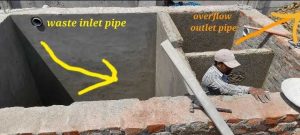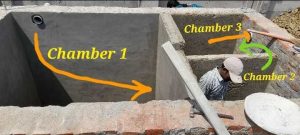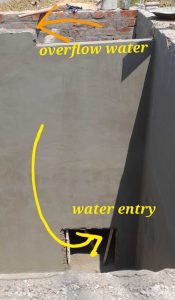You should know the design septic tank is the most SERIOUS component, whose failure is certain if not constructed under proper guidance. A septic tank is an integral part of the building and its design should be according to members and their sewage.
Practical Septic tank design has been explained in this blog, if you have any doubts regarding your own septic tank design, Read this reference, and you’ll know the total design part and all things.
The wrong design of the septic tank leads to the following Problem
The Septic Tank could leak, And fill very fast. Also, rainwater could enter.
Homemade Septic Tank Design Process
Design Septic tank should be focused on the volume of the tank, paying attention to the steam vent system, suffocation, and the phenomenon of breaking the enamel membrane to help destroy the shit itself.
In this blog, we’ll be discussing rectangular safety tanks. Designing a Septic tank is an easy task if you follow the following details step by step.
Dig a trench
First dig a trench of proper dimensions such as 16 X 11 X 12 means a length of 16ft, width of 11 ft, and depth of 13 feet. Use GCB or manual. Manual Digging will take more time. So using JCB costs 1100 Rupees per hour.
After that, make it plain from all the sides so that it takes the size of a cuboid box which takes standard septic tank dimensions of 15 X 12 X 10. all dimensions are in Feet.
Soling
20 mm broken stone for Concreting the floor of the septic tank. Or the broken bricks spread over the whole bottom surface.
Make pillar/Column
Pillars are necessary to construct in 4 corners. For that Footing is necessary. Then construct a 4 Inch Concrete Slab with reinforcement. Use 12 mm bars on all sides of columns and stirrups of 6mm with 6 Inc C/C Distance.
PCC in bottom
After soling, a 4-inch PCC is necessary to give the proper strength to the bottom. Also, to take the load of all the walks of the septic tank.
RCC Slab design
After PCC, Reinforcements cement concrete is required to give strength as well as to prevent leaking of water.
Here, the bar should be From the shorter side and distribution bars from the longer side in the slab design.
A minimum of 10 mm of steel will be used in the RCC slab. Reinforcement slabs than septic tank walls are constructed.
Sloping of the Floor Bed
slope in the floor and a manhole cover in each part is necessary. The thickness of bed concrete should be more on the outlet side and less on the inlet side.
Wall thickness
Many people Design Septic tanks using RCC as well as Bricks. But it’s recommended that If water is nearby then use RCC. and If water is not nearby then use brick.
Jhama Brick walls are the preferred septic tank design in India because they are
good and economical. You can make Concrete walls instead of 9-inch brick walls.
Outside wall thickness- 20 cm
Partition (inner wall) wall thickness- 5 cm- partition walls are necessary for the water to Overflow over the Wall.
Plaster of Walls
Plastering increases the strength of the wall. All the walls of the septic tank should be water tied. To do this, the Walls of the septic tank are required to be plastered, even partition walls.
Plastering is needed on the inner side and after that pinning is also needed to not allow water seepage. Plastering of 12 mm is enough.
Septic tank slab casting above the tank
After completing all the walls, a 4-inch slab is covered all around the tank, and packed for the Anaerobic process.
Standard septic tank design
Here you’ll know the dimensions of a septic tank. It is decided by a number of factors such as Design for the number of members, Volume of the tank.
Length- 15 feet
Width- 10 feet
Depth- 12 feet
Important Note– For proper detention time, the length should be greater than 2 to 3 times of width.
Someone can prefer these standard dimensions for 8 to 10 people in a house.
Width- 750 mm
Depth of septic tank- 8 to 10 feet
Brick use
Jhama or over-burnt bricks are used to construct the wall of the septic tank. These bricks are very hard in nature and the advantage of using these bricks, they Don’t allow water to seep through the walls.
Input Pipe/Inlet

The inlet pipe must be kept below the level of the outlet pipe. A polish layer is formed on the top of the intake material which prevents the passing of odor/gas to come out and to avoid this inlet pipes are kept below the level of the outlet pipe.
Some may construct the ground floors only with future plans for first-floor construction. For that, if we provide the input (pipe)of the septic tank, it is suggested to provide one TEE pipe in a suitable place-location with a dummy cap so that in the future first-floor construction, it will be easy to connect the first-floor toilet outlet to this septic easily.
Overflow pipe/ Outlet Pipe
In the future when it is necessary to clean the septic tank, on top a 6 ” dia PVC pipe should be provided. It will easily be for future cleaning with compressor-type cleaning. make sure where to put the overflow pipe and how to put it in the proper place to make efficiency correct.
Where the inlet falls, its hole will be at a lower height and the hole of the 2nd wall will come up and the gas pipe will remain in the last partition.
In the outlet, There should be a bend (submerge) so that the gas and the smell do not come out. The height of the outer pipe from the center wall is 3″.
And finally, the outlet can directly have a pipe from WC to the sewer/manhole for waste disposal
Steam pipe Installation
In the septic tank, there should be a steam pipe for 2 reasons
- When the shit decomposes, producing a gas like microbiological gas, there must be a steam pipe to release the pressure generated by the gas.
- Excessively generated gas without a released steam pipe, will increase the pressure on the airy surface, and have the effect of increasing pressure causing a more difficult draining phenomenon known as suffocation.
Note that if the good design should not let the shit fall freely, will break the enamel membrane formed on the airy surface, but also avoid plugging the tube deep under the water surface because it will suffocate, suggesting these two points both of the above requirements.
In some places where there is a high demand, the third tank compartment needs filtering materials such as sand, gravel, and coal (to deodorize). If the filter material does not work well for a long time, it must be replaced.
For vent pipe installation in the septic tank
you need a vent pipe (Air Pipe) at one or two places.
Septic tank design 3 Chambers

If you want to have a 3-chamber septic tank then your designing process would be like the above. But, You should know the following details also of each member.
Chambers in The Septic Tank and their working process
1st Chamber

In the first chamber, PCC will be level or a little bit of slope required. In the first Chamber, the first Buffel wall has a window on the inlet side which does not go to the slab. The 1.6 ft hole in the inside wall should be in the center.
2nd Chamber
2nd Chamber starts with a Hole in the wall that should be 1.5 feet, ie height 1’6″ from the bottom slab.
The minimum size of the septic tank hole in the 2nd wall must be 1’6″ X 1’6″. But many people prefer height should be greater than width.
There should be a Freeboard which should be a minimum of 9″
(Inlet top and outlet bottom)
3rd Chamber
The 3rd compartment is not necessary, if provided then it should be porous which acts as optional to soak it and hence too economical.

House Septic Tank Design
It’s not any special design. But for the house used the septic tank shouldn’t pollute nearby water sources.
The safe distance between the toilet septic tank and the drinking water well should be at least 15 m. Or it depends upon how much area you have. And also depends upon the topography of the land, whether it is a hilly train or plane area.
a doubtable question would be how much water or up to what height water should be filled in all 3 chambers.
Cleaning of Septic Tank
For a 10-15 member family, 10 Years will last approx before it needs cleaning. Or when the septic tank is getting full, then clean it.
If the drainage system is not there then a soak pit is necessary along with a septic tank to increase the cleaning duration.
Special Guidance regarding the Design Septic tank
- You can’t put tap and kitchen water in the septic Tank.
- You can construct a toilet exactly over the septic tank.
- 5 to 10 feet away will the soak pit be made from the septic tank.
- Beam or tubing can come out from inside the septic tank
- Design bio septic tank for environmental protection.
- To stop leakage problems in the septic tank- it is recommended that you do not use phenyl. And through some fat in the commode at a gap of 3 to 4 days up to 2 weeks.
Cost of Septic Tank
For 5000-liter septic tank capacity- 35,000 Rupees.
NOW A DAYS ABR (Anaerobic Baffled reactor) IS USED WHICH DIFFERENT INTERNAL CHAMBER DESIGN.
In the next blog, you’ll know about the Vastu compliance of septic tanks.
If you’ve any doubts or want to ask any questions regarding problems with your septic tank, comment please 😊. Comment now!
Also Read-
How to design a Home Boundary wall
Building Column Footing- Site images and Detail





This article provides a great overview of septic tank design, with clear explanations on factors like sizing and layout that are crucial for optimal performance. As a general contractor, I found your approach to designing septic tanks for various soil types particularly relevant. It’s often challenging to balance efficient wastewater treatment with environmental impact, especially in soil that doesn’t drain easily. Your points on tank placement and drainage field considerations for different terrains are really helpful.
Do you have recommendations for specific materials or construction methods that enhance longevity in areas with heavy clay soil? It would be helpful to learn how to further support septic systems in challenging soil conditions.